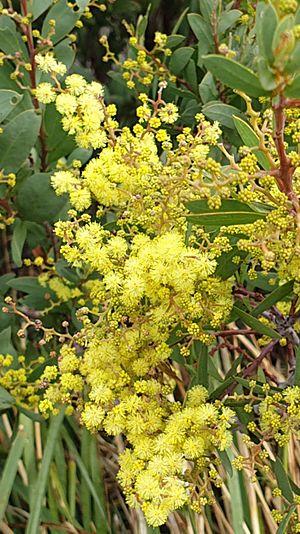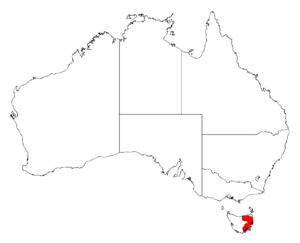Acacia pataczekii facts for kids
Quick facts for kids Acacia pataczekii |
|
|---|---|
 |
|
| Onset of flowering in late winter | |
| Scientific classification | |
| Genus: |
Acacia
|
| Species: |
pataczekii
|
 |
|
| Occurrence data from AVH | |
Pataczek's wattle (also called Wally's wattle) is a special kind of flowering plant found only in Tasmania, Australia. It's a rare plant that belongs to the legume family. This plant is an evergreen shrub or a small tree. People often grow it in gardens because it's very pretty. It's also known for being super tough against frost, more than any other Acacia plant.
Contents
What Pataczek's Wattle Looks Like
Pataczek's wattle is a shrub or tree that grows straight up. It can reach 4 to 6 meters tall, and sometimes even 9 meters. Its bark and branches often have a whitish, powdery look, which is called pruinose. Young branches are usually angled and can be reddish-brown if they get a lot of sun.
The adult leaves are actually flattened leaf stalks called Phyllodes. They are grey-green or bluish and smooth. These phyllodes vary in shape and size. They can be narrow, oval, or wider at the tip. They are usually 2 to 6 cm long and 8 to 20 mm wide. Each phyllode has a sharp tip, thick edges, and a clear middle vein.
You'll find a small, oval gland on the upper edge of the phyllode, about 2 to 4 mm from its base. The flowers usually appear in spring. They grow in clusters longer than the phyllodes. These clusters have 10 to 15 bright yellow, round flowers. After flowering, flat, narrow seed pods form. These pods are 2.5 to 4.5 cm long and 7 to 11 mm wide. The purplish-brown pods hold 3 to 6 flat, brown seeds.
How Pataczek's Wattle Got Its Name
The plant Acacia pataczekii was first officially described in 1974 by Dennis I. Morris. A forester and plant collector named Wolfgang "Wally" F. Pataczek found the plant. He brought it to the attention of the Tasmanian Herbarium in 1970 and 1972. Because of his discovery, the plant was named in his honor.
In the past, people sometimes confused this plant with other similar wattle species. These included Acacia melanoxylon, Acacia myrtifolia, and Acacia mucronata. Some even thought it might be a mix of different plants because it's so rare. However, it has many unique features that make it different.
This wattle is most closely related to Acacia kettlewelliae. That plant has longer phyllodes and its gland is further up the stem. Its pods are also longer, about 5 to 10 cm. Acacia kettlewelliae only grows on the mainland of Australia, not in Tasmania.
Where Pataczek's Wattle Lives
Acacia pataczekii is native to the island of Tasmania, Australia. It grows in specific areas, mostly in the northeast part of the island. You can find it at high places, usually between 500 and 1400 meters above sea level. However, some natural groups of these plants also grow in the Southern Midlands Region. It also grows well in gardens at sea level.
In nature, it grows as a shrub layer or a small tree under taller trees. You can also find single plants scattered in moist gullies and flat areas. It likes mountain tops, slopes, and plateau edges. It grows in different types of Eucalyptus forests, from low woodlands to tall, open forests. Many of these forests are dominated by Eucalyptus delegatensis trees.
How Pataczek's Wattle Survives
Pataczek's wattle lives in a cool temperate climate in its natural home. At high altitudes, it faces strong cold winds, frost, and snow. This plant can grow in many different types of soil and on various slopes. It needs about 750 mm to 1500 mm of rain each year.
In some places, the soil is shallow and dries out quickly. This shows that the plant can handle dry conditions. It also has a very good system for moving water inside its body. Pataczek's wattle can make new plants in two ways: from seeds (sexual reproduction) and from its roots (vegetative reproduction). It often grows new shoots from its roots or the base of the tree. This happens after things like trees falling, animals digging, or fires.
Bees are most likely the main pollinators of its flowers. However, flies and spiders have also been seen visiting the flowers. Getting enough seeds can be hard because insects often eat or damage the flowers. After a fire or other event that clears space, seeds from previous years or from the soil can easily sprout. But too many fires can harm A. pataczekii. A fungus called Phytophthora cinnamomi can cause Root rot, but it only has a small effect on this plant.
Like other plants in the Fabaceae family, Pataczek's wattle helps the soil. It takes nitrogen from the air and puts it into the soil through its root nodules. This makes the soil richer for other plants. This plant has also been known to mix with Acacia dealbata in the wild and in gardens. This mixing is called hybridization.
Protecting Pataczek's Wattle
Acacia pataczekii is listed as a Rare plant under Tasmanian law. This means it's against the law to destroy or collect wild plants without a special permit. There are also rules about sending plant material out of Tasmania. However, there are no rules about bringing its seeds into Australia.
Some healthy groups of these plants live in protected areas. These include Ben Lomond National Park, Gravelly Ridge Conservation Area, and St Paul's Regional Reserve. Other groups grow on private land and in forests used for timber. Special care must be taken when cutting timber in these areas. Also, people looking for minerals might not be allowed to mine if it would harm the plants.
Efforts are being made to protect the plant outside its natural home. This includes growing it in special seed gardens and planting it in new areas. Seeds are also stored to keep them safe. The biggest threats to Pataczek's wattle are more frequent fires, clearing land, insect attacks, and the Phytophthora cinnamomi fungus. Protecting more areas would help reduce these threats. Acacia pataczekii is not known to spread aggressively outside its native range.
Growing Pataczek's Wattle
Pataczek's wattle is not a common garden plant, but many gardeners want it. It grows best in a sunny or partly shaded spot that is protected from strong winds. It likes cool or warm climates. This is a tough plant that can survive very cold winters, even down to -18 °C. It can also handle dry periods and grow in most types of soil.
It grows at a medium to fast speed. A plant can reach 2 to 3 meters tall within 5 years from a seedling. It usually starts to flower around the same time. People grow it in botanic gardens and home gardens all over the world. You can use it as a natural fence, a screen, or a single special plant in your garden.
In late winter to early spring, the flower buds form. Then they burst into many bright yellow flowers, sometimes covering the leaves completely. If the conditions are right, a second set of flowers can appear in summer. New leaves are blue-green and feel soft. They grow on reddish-brown, angled stems. New shoots can grow from the roots if the soil nearby is disturbed. You can also grow it in a pot if you keep the soil moist.

